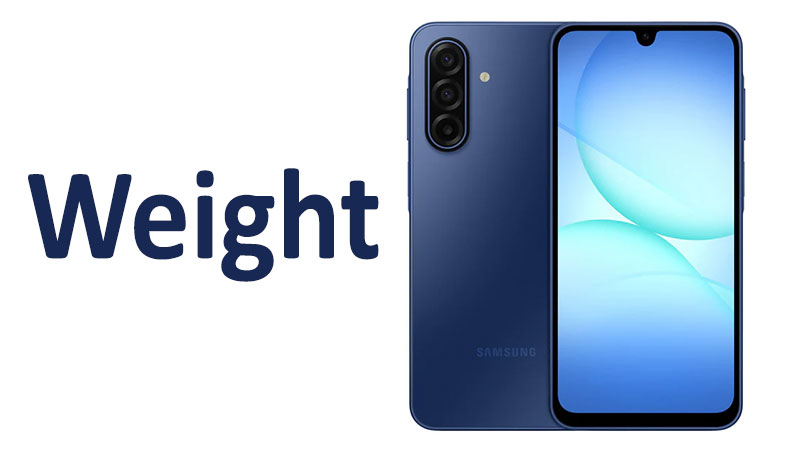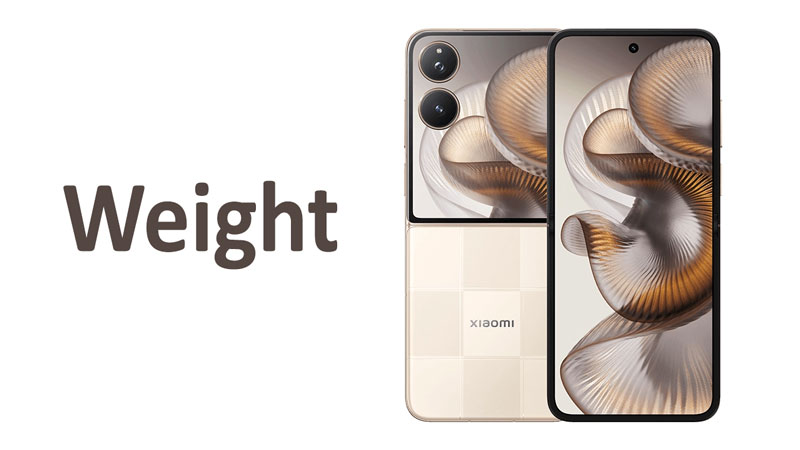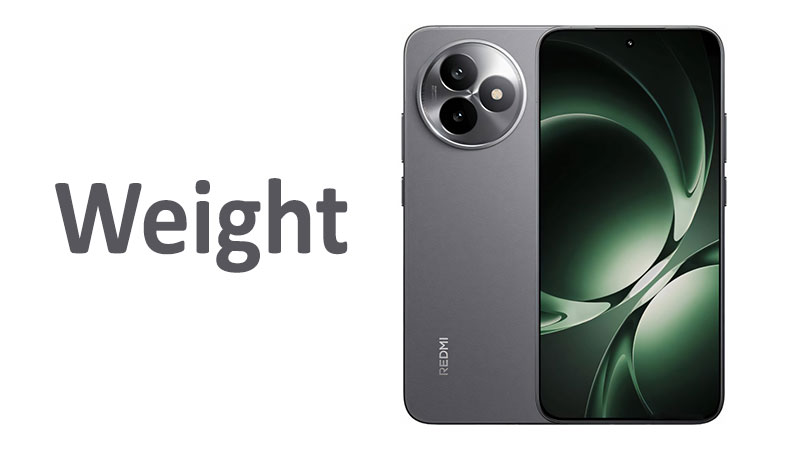The Samsung Galaxy A17 weight is a crucial factor for user experience and portability. This detailed analysis covers the exact specifications and explores how the device’s mass of 192 grams (6.77 ounces) impacts daily use. Understanding a smartphone’s physical attributes, particularly its weight, is essential for potential buyers. The weight influences everything from comfort during long calls to how the phone fits in your pocket. This article provides a comprehensive look at the A17’s heft, contrasting it with other devices and examining the engineering choices behind its construction.
Official Samsung Galaxy A17 Weight Specifications
The official specifications confirm the precise weight of the Samsung Galaxy A17. The device registers at 192 grams, translating to 6.77 ounces in the imperial system. This measurement places the A17 firmly in the standard weight class for modern budget and mid-range smartphones. Modern phones often carry substantial weight due to large batteries and expansive screens. This specific figure of 192g reflects a balance between necessary hardware and ergonomic design.
Grams: The Metric Standard
The metric measurement of 192 grams is the internationally accepted standard. Most manufacturers and tech reviewers use grams for accurate comparison. This figure is slightly below the 200-gram mark, which is often considered the boundary for a “heavy” phone. Engineers optimize every component to hit a target weight like this one. For many users, 192g provides a satisfying, substantial feel in the hand.
Ounces: The Imperial Context
In the imperial system, 192 grams converts to approximately 6.77 ounces. Users in the United States and other imperial system countries may find this number more relatable. This weight is comparable to a medium-sized apple or a standard baseball. Knowing the weight in ounces helps consumers visualize the phone’s presence. Six to seven ounces is light enough for easy handling but heavy enough to feel durable.
The Significance of 192 Grams
The 192-gram weight is not arbitrary; it signifies specific engineering priorities. Primarily, this mass is dictated by the large battery cell. The display size and internal cooling mechanisms also add to the final figure. Achieving this weight requires careful material selection, often utilizing strong yet light polymers for the backplate. The result is a device that balances battery performance with portability constraints.
Weight in the Context of Design and Materials
The overall weight of a smartphone results from the aggregate mass of its individual components. For the Samsung Galaxy A17, the combination of a robust frame, a large display, and a powerful battery leads to the 192g figure. Understanding the internal and external materials helps explain this specific density. The engineering team makes calculated trade-offs between cost, durability, and weight.
The Chassis and Frame Composition
The A17, like many phones in its segment, typically uses a polycarbonate (plastic) frame and back panel. Polycarbonate is significantly lighter than the aluminum or glass used in premium flagship models. This choice helps to keep the total weight at 192g. The plastic construction also provides resilience against minor drops and scratches. However, the internal structural components still use metal alloys for stability. These internal supports ensure the phone remains rigid under pressure.
Display Technology and Weight
The display module itself is a major factor in the final weight calculation. The A17 features a large screen, likely around 6.6 inches. The glass panel, digitizer, and necessary backlighting layers contribute notable mass. If Samsung used an AMOLED screen, the display assembly would be slightly lighter than a traditional LCD panel. This is because AMOLED panels do not require a separate backlight layer. Every millimeter of screen size adds weight, making the 6.6-inch diagonal a significant contributor to the 192g.
Ergonomics and Hand Feel
Ergonomics are directly tied to the 192-gram weight. A device that is too light can feel fragile or cheap. Conversely, a phone that is too heavy causes hand fatigue. The Galaxy A17’s weight is distributed evenly across its body. This balanced density is crucial for comfortable single-handed operation. The phone feels secure and well-built without being burdensome. Proper weight distribution enhances grip and reduces the risk of accidental drops.
The Battery’s Contribution: Why 192g?
The single largest factor influencing the Samsung Galaxy A17 weight is the battery. Modern smartphone users demand long battery life, necessitating high-capacity cells. The A17 is widely expected to feature a 5000 mAh battery, which is standard for day-long usage. The sheer volume and density of lithium-ion cells account for a substantial percentage of the device’s 192 grams.
Battery Capacity vs. Weight Trade-off
There is a direct correlation between battery capacity and physical weight. A 5000 mAh cell requires a certain amount of lithium, electrolyte, and casing material. If Samsung had aimed for a much lighter phone, perhaps under 170g, they would have likely reduced the battery capacity to 4000 mAh or less. The 192g mass is a necessary trade-off for the excellent battery longevity that users expect. This compromise ensures extended screen-on time and fewer charging cycles. Buyers must decide if portability or endurance is their higher priority.
Fast Charging Components and Mass
Beyond the cell itself, the components necessary for fast charging also add a small amount of weight. These components include specialized circuitry, thermal pads, and reinforced connection ports. These elements are designed to handle higher current and dissipate heat safely. While these additions are minimal individually, they contribute to the overall 192g total. They are essential for modern convenience, allowing the phone to recharge quickly.
Internal Weight Distribution
Samsung’s engineers meticulously place components to achieve optimal weight distribution. The battery is usually centered within the chassis for balance. This centralization prevents the phone from feeling top-heavy or bottom-heavy. When a user holds the 192g device, the weight feels stable and predictable. Good internal design makes the phone feel lighter than its actual mass suggests.
Specialized Comparison: A17 vs. Predecessors
Comparing the Samsung Galaxy A17 weight to its immediate predecessors provides valuable context. The previous models in the A-series, such as the Galaxy A15 or A14, typically weighed slightly more due to evolving component sizes. Understanding this evolution shows Samsung’s continued focus on refining the A-series design. This comparison highlights improvements in material science and engineering.
Samsung Galaxy A17 (192g) vs. Galaxy A15
The Samsung Galaxy A15 5G weighed approximately 200 grams. This makes the newer Galaxy A17, at 192g, a notable 8 grams lighter. This reduction, though small, represents an important design optimization. It suggests more efficient internal component arrangement or a slight decrease in case thickness. An 8-gram difference improves the feel, especially during extended use or when placed in a tight pocket. The lighter weight enhances the perception of a streamlined device.
Evolutionary Design Choices
The shift from 200g to 192g is part of a broader trend toward lightness and slimness. Even with demanding large batteries, manufacturers try to shave off every possible gram. The A17 maintains a large screen and battery while achieving a reduced weight. This optimization is possible through the use of lighter but equally durable plastics. It demonstrates Samsung’s continuous effort to improve the A-series ergonomics.
Thickness and Weight Perception
Weight perception is also tied to the phone’s thickness. The Galaxy A17 is likely slimmer than its predecessors, which makes the 192g feel less dense. A thinner phone distributes the weight over a smaller volume, making it appear less bulky. A compact design minimizes the physical imposition of the device. This improved thickness-to-weight ratio is a critical factor for user satisfaction.
Specialized Comparison: A17 vs. Competitors
The budget smartphone market is highly competitive, and device weight is a major differentiator. The Samsung Galaxy A17 weight of 192g sits comfortably in the middle of this competitive landscape. Comparing it to models from rivals like Xiaomi, Motorola, and others is essential for a complete picture. This helps buyers understand how the A17 stacks up against similar-priced offerings.
Competing Budget Phones (185g to 205g)
Most budget competitors house similar large 5000 mAh batteries. As a result, many popular models hover around 195 to 205 grams. A phone like the Xiaomi Redmi Note series often sits near the 200-gram mark. Motorola’s budget G-series also frequently crosses the 190g threshold. Consequently, the A17 at 192g is neither the lightest nor the heaviest in its class. It offers a balanced weight profile, which is a selling point for general consumers.
Featherweight vs. Durable Designs
Some budget phones prioritize being featherlight, dropping below 180 grams. These lighter phones usually compromise in one of two areas: battery size or build quality. They might use a smaller 4500 mAh battery or thinner, less robust plastic. The A17’s 192g suggests a preference for durability and a high-capacity battery. The extra mass implies a slightly more solid and well-protected internal structure. This appeals to users who prioritize robustness over extreme lightness.
The Role of Premium Materials in Weight
In contrast, flagship phones using heavy glass backs and stainless steel frames often exceed 210 or 220 grams. These premium materials add significant weight but offer superior aesthetics and feel. The A17 avoids this heavy construction by using polycarbonate. Therefore, the 192g is considered lightweight when compared to high-end devices. It achieves a balance between the lightness of plastic and the necessary heft of a large battery.
The Pros and Cons of a 192g Smartphone
Understanding the exact weight is only useful when analyzing its practical implications. The 192g mass of the Samsung Galaxy A17 brings distinct advantages and disadvantages to the user experience. These factors heavily influence purchasing decisions and daily interaction with the device. It is important to consider both the positive and negative aspects of this specific weight.
Pros: Durability, Battery Life, Premium Feel
First, the 192g weight suggests enhanced durability. The mass implies that the internal frame is strong and well-supported. The phone is less likely to feel flimsy or hollow in the hand. Second, this weight is a clear indicator of the excellent battery life provided by the large cell. Users benefit from all-day power without needing constant recharging. Finally, many users associate a moderate heft with a “premium” or well-built device. The A17 avoids the cheap, toy-like feeling of ultra-lightweight plastic phones.
Cons: Pocketability, Fatigue, Single-Hand Use
One disadvantage is reduced pocketability compared to sub-170g phones. The 192g, combined with its dimensions, creates a noticeable presence in tight jeans pockets. Second, users who consume content for extended periods may experience hand fatigue. Holding a 192g device for an hour-long movie can become uncomfortable. Third, while generally balanced, reaching the edges of the large screen during single-hand use is more challenging with a heavier device. This increased mass requires a firmer grip to maintain stability.
Impact on Active Users
For active users, like runners or cyclists, weight matters significantly. A 192g phone, especially when secured in an armband, is quite noticeable. It adds substantial bulk to workout gear. Lighter phones are often preferred for purely athletic purposes. However, the A17’s weight is tolerable and is a worthwhile trade-off for its long battery life. This endurance is essential for tracking long hikes or bike rides.
Important Points for Buyers and Readers
Before finalizing a purchase, potential buyers must consider the practical implications of the 192g Samsung Galaxy A17 weight. This device’s heft influences the selection of accessories and the user’s overall satisfaction. Buyers should always consider how they intend to use the phone most often. These points offer helpful advice for a well-informed decision.
Considering Accessories (Case and Screen Protector)
The 192g weight is a baseline measurement for the naked phone. Almost all users immediately add a case and a screen protector. A standard protective case can easily add 20 to 40 grams to the total weight. This addition pushes the total weight to between 212g and 232g. Buyers must budget for this extra mass when evaluating the phone’s portability. A heavy-duty, rugged case will add even more bulk and weight.
The Perception of Quality and Density
The density of the phone often contributes to the perception of its quality. Density is calculated by dividing the weight (192g) by the volume (based on its dimensions). Since the A17 uses a large battery, its density is likely high, making it feel solid and well-made. This feeling of solidity is a major psychological benefit. A denser phone often gives the impression of premium internal components.
Target User Profile
The 192g Galaxy A17 is best suited for a specific user profile. It is ideal for the person who values battery life above all else. It is also perfect for those seeking a durable, substantial device for everyday communication and media consumption. Users who require a very light phone for specific activities might find the A17 slightly heavy. However, for the average consumer, this weight is perfectly acceptable and offers many advantages.
Balancing Weight with Dimensions
A phone’s weight must always be considered alongside its physical dimensions. A very large phone can effectively distribute a higher weight, making it feel less heavy. Conversely, a small, thick phone can feel deceptively heavy even at a lower mass. The A17’s dimensions, combined with its 192g mass, result in a favorable weight-to-size ratio. This ratio ensures a comfortable and balanced device for most hand sizes.
Pros and Cons Revisited: Weight-Specific Factors
Let us look again at the specific aspects where the 192g weight either benefits or hinders the user experience. This detailed breakdown ensures no aspect of the phone’s mass is overlooked. Analyzing these factors is key to determining if the A17 is the right choice for an individual buyer.
Pro: Enhanced Media Viewing Stability
The 192g weight is advantageous when the phone is rested on a surface. It provides stability for watching videos or making hands-free video calls. The device is less likely to slide or move when touched or when placed on a table. This stability enhances the media consumption experience. Lightweight phones can sometimes be too easily nudged out of position.
Con: Magnetic Mount Issues
For users who rely on magnetic car mounts, the 192g weight requires a strong magnet. Weaker magnetic mounts may struggle to hold the phone securely, especially over bumpy roads. This is a niche concern, but a relevant one for drivers. Users should ensure they purchase a car mount rated for heavier devices.
Pro: Better Haptic Feedback Perception
The solid mass of 192g often improves the perception of haptic feedback. The vibrations from notifications and keystrokes feel more grounded and precise. A lighter phone sometimes produces a buzzing vibration that feels less refined. The A17’s weight contributes to a satisfying and tactile user interface. This is an often-overlooked benefit of a moderately heavy device.
Con: Increased Drop Damage Potential
A heavier object hits the ground with greater force, which increases the potential for damage during a fall. The 192g weight means the impact force is higher compared to a 160g phone. This makes the use of a protective case even more critical for the Galaxy A17. The phone’s mass demands better physical protection.
Conclusion: Making an Informed Decision
The Samsung Galaxy A17 weight of 192 grams (6.77 ounces) is an important specification. This mass places the device in the optimal category for a modern budget smartphone. The weight is a clear indicator of the generous, all-day battery life and the phone’s overall solid construction. It is slightly lighter than its immediate predecessors, showing an evolution toward refined ergonomics.
Buyers prioritizing durability and extended use will find the 192g perfectly acceptable and reassuring. However, users seeking an ultra-light device for athletic pursuits should consider the added mass of a case. Ultimately, the A17 successfully balances a large screen, excellent battery capacity, and a comfortable, manageable heft. This is a well-engineered device that delivers on performance and feel.
Frequently Asked Questions (FAQ)
1. Is the Samsung Galaxy A17 considered a heavy phone?
No, the Galaxy A17, at 192 grams, is considered a moderate-weight phone. This weight is typical for modern devices featuring large screens and 5000 mAh batteries.
2. How much weight does a typical phone case add to the A17?
A standard protective case usually adds between 20 and 40 grams to the total weight. This means a cased A17 will typically weigh between 212 and 232 grams.
3. Does the A17’s battery size affect its 192g weight?
Yes, the large battery is the main component contributing to the A17’s 192-gram mass. The high capacity ensures long battery life, which requires denser materials.
4. How does the A17’s weight compare to a premium phone?
The A17 at 192 grams is significantly lighter than most premium flagship phones. Flagships often use glass and metal, pushing their weight closer to 210 or 220 grams.
5. Does the weight of the Galaxy A17 help with durability?
Yes, the 192g weight suggests a solid internal structure and use of robust materials. This moderate mass often translates into a feeling of better build quality and reduced fragility.



